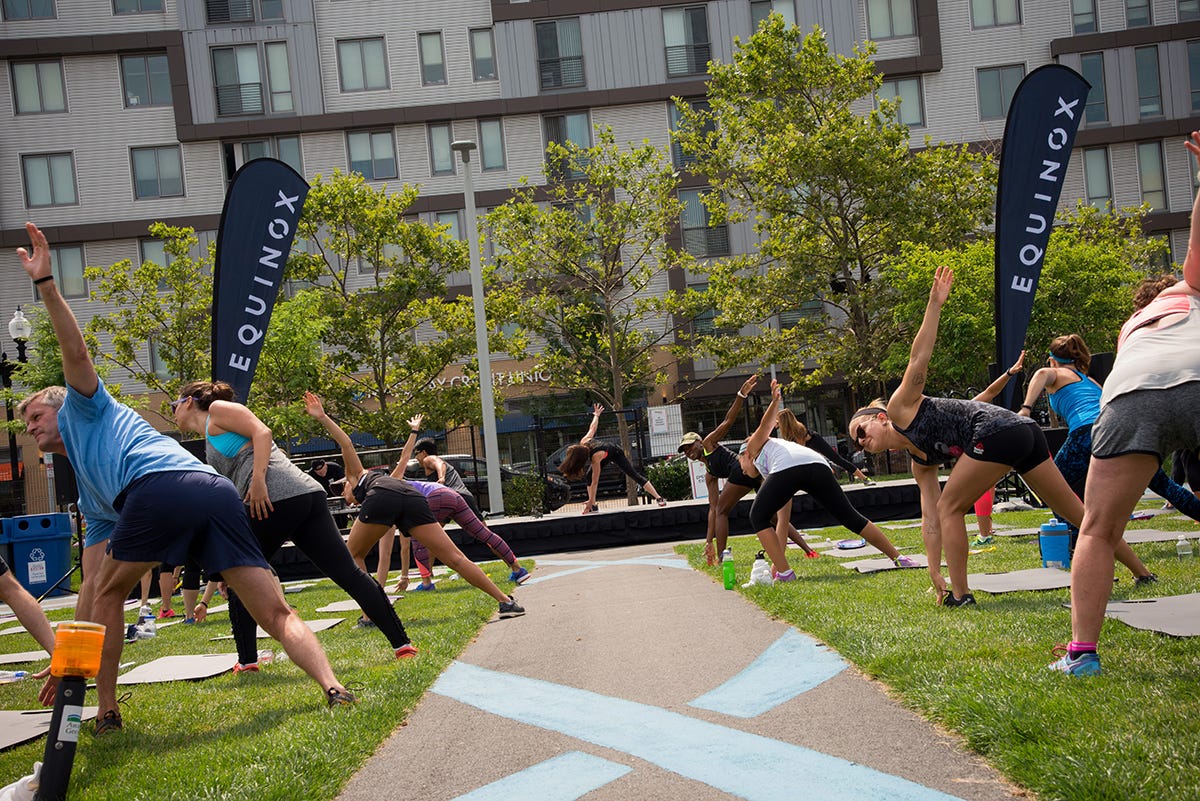The Seaport District: Boston's Generic City
Martin Scorsese’s 2006 crime drama The Departed offers a window into the Boston waterfront just before shovels broke ground on the Seaport District — a $22 Billion megadevelopment that repurposed a vast industrial area across the channel from Downtown Boston to host the city’s tech elite. For Scorsese fans, “344 Wash” is the place “where Queenan died,” an abandoned brick building where Leonardo Dicaprio, Anthony Anderson, and Martin Sheen’s characters each met their demise in the director’s Boston noir gangster film. If Scorsese were to have made this scene in 2021, he likely would have chosen a different location. The fictional address in an alley between Farnsworth Street and Thompson Place is at the center of Boston’s “newest neighborhood” and hosts popular amenities for young entrepreneurs such as a Capital One Cafe, Trader Joes, and Trillium Brewery.
Boston’s Seaport District is like if New York’s Hudson Yards was flipped on its side. It features the same old chains (Sweetgreen, Equinox, Starbucks) inside buildings by the same old architects (Diller Scofidio, OMA, Rafael Vinoly) that max out at about twenty instead of one-hundred stories. Big signs with words like GATHER and EAT are everywhere. The place is a sea of tired looking thirty-something white people wearing Vineyard Vines, Patagonia, UNIQLO, Lululemon; and university apparel from schools such as NYU, Stanford, Northwestern, Harvard and Yale. A friend described the architecture as “algorithmically generated urban consensus aesthetics.”
Unlike Hudson Yards, the Seaport is not easily accessible by public transit. New York extended the 7 train to its west side in 2015 to anchor the megadevelopment but the Seaport is only serviced by a bus line connected to South Station, which is fifteen minutes away by foot. Lack of public transit only deepens the economic and racial homogeneity suggested by the shops and luxury apartments. It’s a reminder that the Seaport provides little civic value besides a place for the rich to wine and dine.
For three summers in college, I interned at an office not far from 344 Wash. At night, I worked as a doorman at a pub a few blocks over which has since been demolished for a luxury residential tower. I’ve seen the Seaport’s transformation first hand as a bouncer, architect, and citizen from Dorchester — a working class, predominantly immigrant Boston neighborhood where I grew up less than two miles from Downtown.
After reading a draft version of this very article, my mother hastily reminded me that the Seaport is in fact “not a neighborhood at all,” despite the strenuous efforts of the Seaport’s marketing staff to claim otherwise. My mom rightly notes that “there are no schools or libraries. It is a district that serves suburbanites who eat, work, and leave the city. There is no public transportation. Valet parking and Uber are its only options.” How did Boston end up with a non-neighborhood neighborhood? Here are my thoughts about Boston’s newest destination, and an attempt at an answer.
My first impression of the Seaport district was in 2013 when the Institute of Contemporary Arts (ICA) by Diller Scofidio + Renfro hosted the Red Bull Diving Competition. The building’s famous cantilever that hovers out over Boston Harbour was repurposed and rebranded by Red Bull as an “urban cliff” for the world’s best divers to jump off of in front of thousands of cheering drunken spectators hopped up on free energy drinks. That year, a Michigan native wearing Oakley sunglasses won first prize in the competition. The diving champion described the experience of leaping from Diller Scofidio’s building as, “just sweet.”
For my neighbors in Dorchester, the Red Bull Diving Competition was just another pain to deal with on their way to work. Neither myself or anyone that I know from my home neighborhood has ever paid the ICA a visit.
Like the Whitney Museum in New York City, the ICA was a catalyst for the gentrification of a de-industrialized area just outside of a major business district. Prior to the ICA’s construction, the Seaport was known for its vast parking lots, derelict factory buildings, fish markets, and a few local watering holes; much like Manhattan’s west side before the construction of the High Line. The Boston Convention and Exhibition Center by Rafael Vinoly was the first building by a famous architect in the area completed in 2005 which was shortly followed by the ICA in 2006. An abyss of generic glass towers by big three architecture offices (Gensler, SOM, AECOM) grew around these buildings like weeds in the decade to come. Also like the Whitney, the ICA’s reputation is shrouded by murky figures from the city’s business elite. One of its most notorious board members is Gerald Fineberg, a man who has been described as “Boston’s biggest slumlord”. The Fineberg Tenants Union (FTU) organized outside of the ICA in 2020 to protest the abhorrent living conditions they were being subjected to and how the museum is leveraged by its board members for tax evasion in the name of contemporary art.
The Seaport as it is being built today is the manifestation of a long list of allowed variances by the city and outright corruption. The location where a new building by OMA for instance is being constructed was originally zoned as a public park. Instead, the parcel will be used for luxury commercial and office space where a quasi-private terraced park will be located several stories above the street. I remember visiting a zoning board of appeal meeting in 2015 with my neighbors at City Hall when a principal architect from OMA and his lawyer fumbled through a presentation about how their (private) alternative use for the site would fulfill its public demand. After an impassioned presentation by the architect about the building’s Deleuzian folds, a ZBA member scratched his head and replied: “So what you’re saying is that you’re gonna turn the pahk (park) into a jewelry store.” The lawyer whispered something into the architect’s ear, who then replied, “no comment.”
That moment in the dimly lit room in Boston City Hall watching a principal from OMA present 88 Seaport, I recalled reading Rem Koolhaas’ Generic City just a few months earlier as an undergraduate in architecture school. Rem wrote the manifesto for neoliberal capital’s domination of the city and his progeny was performing it right before my eyes.
Public space in the Seaport is an afterthought. The Lawn on D was the first attempt at building shared green space in the area, an Instagram-friendly pocket park financed by Citizens Bank. The parcel where Lawn on D was built was allowed to stay clear of development for the sole reason that it is structurally unfeasible to build a building upon. James Corner Field Operations recently put forward Harbor Way, a plan to “humanise” the Seaport with a new ⅓ mile long pedestrian corridor linking the area across the channel. Over the next few years, Harbor Way will install native New England flora and granite along the pedestrian corridor to make the ground plane slightly less hostile. Construction is expected to be complete in the Seaport by 2024.
No amount of placemaking or greenwashing however will address the core structural issues that make the Seaport a socio-economic heterotopia.
Its median household income is $153,545 — more than double Boston's median income in a city where the average rental cost for a one bedroom apartment is $2,880. Like Hudson Yards, the entire project was financed and subsidized by public money at a cost of $22 billion. In 2016, the city lured General Electric to the Seaport with generous tax breaks at the same time there was a $50 million shortfall in funding for Boston’s public schools. Water-levels in the area are expected to have risen nine inches by 2030, leaving many officials scrambling to boost resiliency in the district which could cost taxpayers another $1.2 Billion to repair in the advent of a single nor’easter.
A disgraced state representative will soon serve eighteen months in prison after being charged in September 2021 with bank fraud for accepting benefits from a local business owner in exchange for pushing through “legislation that provided millions of dollars in tax credits for developers seeking to develop property in Boston’s Seaport district.” This will likely be the first of many corruption scandals that vindicate elected officials in bed with real estate developers in the years to come. Boston mayoral candidate Michelle Wu said recently, “The Seaport is one of the starkest examples of what’s wrong with our development system overall.” Wu has proposed the outright abolition of the Boston Planning and Development Agency (BPDA), the authority responsible for coordinating land use in the city with zero oversight from the city council.
The Seaport is indeed a marriage between government and private interests. It is one of many similar projects built in the US since the 2007 financial crash which represent neoliberal capital’s ideal urban form and its project to eliminate the public sphere from the plane of existence.
OMA, Diller Scofidio, Vinoly, everyone else involved in the Seaport district; they are all complicit in this project as agents of neoliberal capital. Capital bastardizes and burns through everything it touches leaving behind a chemtrail of horrible buildings by bigwig architects (that have the audacity to cite Gilles Deleuze at zoning board of appeal meetings!) and quasi-authoritarian parks patrolled by private security companies where dogs aren’t even allowed to relieve themselves because the next yoga session sponsored by Equinox starts in thirty minutes.







